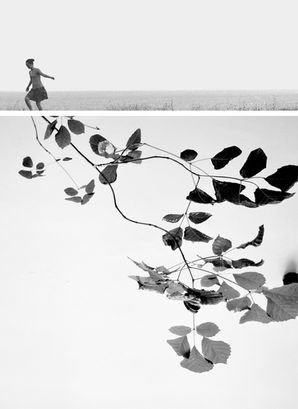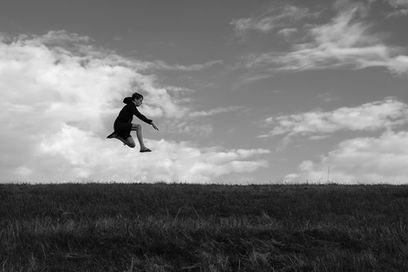
STREET POETRY
March 5, 2021
INTERVIEW
PHOTOGRAPHY Damien Goret
INTERVIEW Melanie Meggs
As a journalist and passionate photographer, Damien Goret has an eye for the seemingly mundane moments that fill our days, from the poetry of a solitary walker to the graphic geometry of light on a sunny day. With his ability to capture deep blacks, pure whites, and all the shadows and highlights in between, Damien Goret's photography breathes life into everyday moments, freezing them in time and reminding us of their beauty. From natural landscapes to cityscapes, each one of his photographs is a unique snapshot of our world.

“I think I've always had, more or less, a taste for photography. I love photography for a simple reason. It allowed me to bypass one of my great weaknesses, one of my great regrets: I am a bad draughtsman. I photograph as I would have liked to know how to draw. By projecting scenes, imagining lines. It is thanks to my work as a journalist that I learned to formalize my practice of photography, to be interested in the settings of a camera, to understand its logical workings.”
IN CONVERSATION WITH DAMIEN GORET
THE PICTORIAL LIST: Damien please tell us about yourself.
DAMIEN GORET: I was born in Brest, one of the westernmost cities in France, 43 years ago. After living 10 years of my youth in Africa, I came back to live, settle, work and start a family in the Region of Brest. I now live in a small town 20 kilometres from Brest, called Plouarzel. Beyond Plouarzel, there is nothing but the sea, then the United States.
TPL: Do you have a favourite quote, lyric, or saying that especially resonates with you?
DG: In terms of photography, I really like this phrase by Ernst Haas: "I am not interested in shooting new things - I am interested to see things new. "
I think it sums up very well the photos I want to make today. I am not looking for the spectacular, but in search of what is spectacular about everyday life, and that too often eludes us.
TPL: Where do you find your inspiration to photograph?
DG: I find my inspiration in the other. The other photographer, the other human, the other draughtsman, the other painter, the other director.
TPL: Your street photography has this wonderful graphic feel to it. What do you want to express through your photography? And what are some of the elements you always try to include in your photographs?
DG: The street photo as I imagine it is a graphic image, yes. I always come back to these stories of shadows, of lights, two elements that alone draw a landscape, a geometry. I'm not very much inclined towards street portraiture. I really want to reveal things that we see every day without seeing them: the shadow of a lamppost on a wall; the shade of the trees on a sunny façade; a person's silhouette, more than the person himself. Because this is the third element necessary for street photography as I imagine it: it is a photo where the human has its place. I like the idea of the gigantism of cities that engulf men.
TPL: What is it that you enjoy about street photography. What happens when you walk the streets with your camera? Explain your technique? Have you ever had a negative encounter?
DG: What excites me is the spectacle that everyday life offers. Things I didn't see before. Places that I have traveled to thousands of times are open to me, one day, in a new light. Because that day, I'm probably more open to the world. Because, on that day, I probably did not know that I had passed this place at the same time as yesterday, and because the light of day makes me see things that did not exist the day before. I love this feeling, this feeling that nothing belongs to me, that nothing is fixed, that today will not look like tomorrow. Photography made my life exciting and allowed me to fight against my anguish of the passing of time, my fear of death. When I'm photographing, I'm stopping it, this time. I'm freezing life. It becomes, for a moment, eternal.
TPL: What is it like photographing on the streets of France? Do you have any favourite spots in France and outside of France to go shoot?
DG: I am a fairly sedentary photographer, but I work in a profession that leads me to move around a lot. It's a real chance, to spot places, geometries. I never go out without a camera. I live and work in relatively small cities, where I am obliged to be on the lookout. I mean: I guess doing street photography is maybe easier in Paris, London or New York.
Photography made my life exciting and allowed me to fight against my anguish of the passing of time, my fear of death.

TPL: What has been the best advice you have ever received in photography?
DG: I think one of the mantras of the wonderful photographer Sean Tucker opened my mind to photography, and especially to street photography, which I now practice 90% of my time: "Embrace your shadows". There is nothing more beautiful than the shadows that come to cut out the lights and shape them.
TPL: Do you have any favourite artists or photographers you would like to share with us, and the reason for their significance?
DG: Clearly, Fan Ho shook me up. Harry Gruyaert too. Among the more contemporary photographers, Sean Tucker inspires me by the elegance of his lines, the quality of his shadows, and the relevance of his eye. On Instagram, where I am a lot, there are also several photographers whose work always makes me think of a tennis player forehand, Tom Schippers, for the loneliness that floods his images; Kentaro Watanabe for his black and white and his sense of graphic design; Ingrid Clauwaert for the vastness of her cities engulfing men; Magali Kermaïdic, whose Brest origins I share but not her talent (laughs); and so many others...
TPL: Does the equipment you use help you in achieving your vision in your photography? What camera do you use? Do you have a preferred lens/focal length?
DG: I am now working with the camera I dreamed of when I started in street photography: a Ricoh GR (the II, in this case). But when I started, I was photographing with an Olympus EM10 Mark II, which I loved. The Ricoh GR II is as I imagined it: a street photo killer. The nose-down of its optics is superlative, maybe even better than the Nikon D7200 that I own in SLR. Its snap mode is truly amazing, once you understand how it works. I just regret it's great weakness in terms of dust, with a sensor that is very sensitive to it. I've had it 3 months, I take great care, and it already has annoying dust specs on the sensor. This Ricoh GR II allows me to make street images that I couldn't have done as easily with my Olympus, let alone with my SLR.
TPL: When you go out, do you have a concept in mind of what you want to shoot, or do you let the images just "come to you", or is it both?
DG: I don't have any ideas when I go to photograph. Like I said, I always go out with my camera. When I see something that appeals to me, and if I have time, I stay put in a spot for 5 to 10 minutes and I wait: I wait for the event that I projected in this scene. Thus, I also have time to adjust my shooting, always in manual mode, to preserve my highlights, respect my shadows. Manual mode is important to me: I want to know everything about my photo, I want to master all the settings...except what will happen there!
TPL: Are there any special projects you are currently working on that you would like to let everyone know about? What are some of your goals as an artist? Where do you see yourself or hope to see yourself in five years?
DG: When I “grow up”, I want to photograph like Tom Schippers 😉! I told him that on Instagram. I always look at his photos and regret not knowing or being able to make them!
I would like to find the courage to exhibit my photos, but I remain someone quite discreet, who has a hard time feeling legitimate in what he does. There is a lot of shyness, and the impression, often, of being an impostor, of not deserving to see my photos recognized. I still judge them pretty badly, even if I like them. But are they worthy of "staying", of being seen...? I have no pretensions in that regard. To exhibit some of them would nevertheless be something I would like to do.
TPL: "When I am not out photographing, I (like to)…
DG: Play a lot of board games with my wife and children. I also ride a lot of road bikes. And when I'm not photographing, I like to look at the world as I would like to photograph it."

Damien Goret's photography has a way of making us pause and recognize the beauty of everyday moments. His photographs capture the poetry in the mundane, the stunning geometry of light, and the vibrant colors of our world. He has an eye for beauty, and his work shows it. If you want to appreciate the world in a way you've never seen before, view more of Damien's work.



































